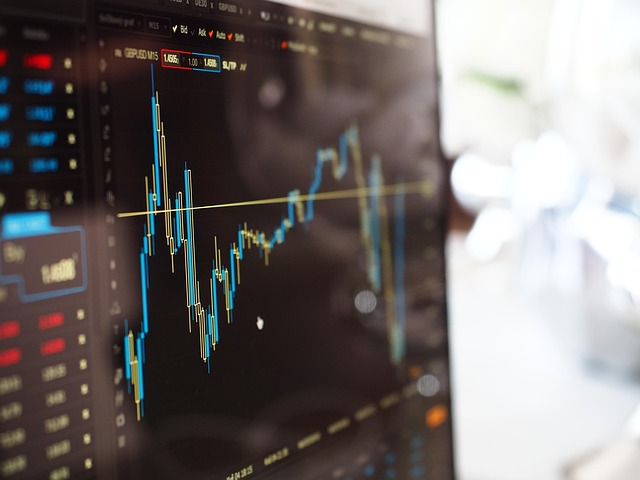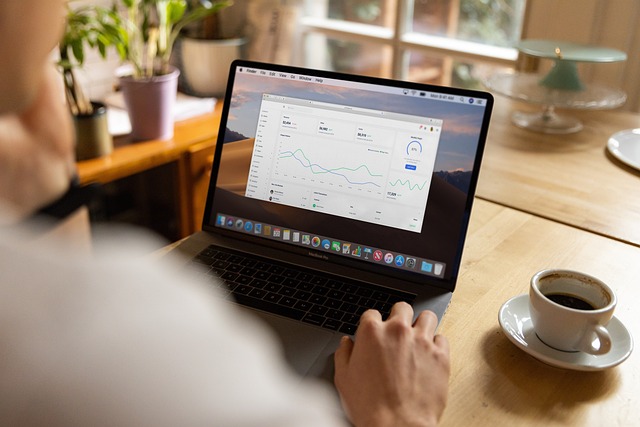What Is TradingView Auto Chart Patterns 2025 Guide
Author: Jameson Richman Expert
Published On: 2025-11-03
Prepared by Jameson Richman and our team of experts with over a decade of experience in cryptocurrency and digital asset analysis. Learn more about us.
What is TradingView auto chart patterns and how can traders use this feature effectively in 2025? This article explains the concept, shows how TradingView detects and labels classic chart patterns, evaluates accuracy and limitations, gives step-by-step usage and setup tips, and provides practical trade examples and best practices. You’ll also find links to further resources, broker options for live trading, and legal guidance so you can apply pattern recognition responsibly.

Quick overview: What are auto chart patterns?
Auto chart patterns are algorithmic detections of well-known technical structures—such as head & shoulders, triangles, double tops/bottoms, and channels—on price charts. TradingView’s Auto Chart Patterns scans price action in real time and visually marks these patterns for traders, aiming to speed up identification and reduce manual scanning time.
Auto detection does not replace analysis; it augments a trader’s workflow by highlighting possibilities that deserve confirmation with volume, momentum indicators, and risk management.
Why Auto Chart Patterns Matter in 2025
With more markets, greater volatility, and faster retail participation in crypto and equities, automated pattern detection saves time and helps traders identify statistically relevant setups across multiple timeframes and tickers. Coupled with alerts and broker integrations, auto chart patterns can become part of a semi-automated trading workflow.
How TradingView Auto Chart Patterns Works
1. Pattern recognition algorithms
TradingView uses algorithmic rules to locate characteristic price swings and geometries of classic patterns. These algorithms analyze:
- Swing highs and swing lows (local extremes)
- Relative ratios and symmetry (e.g., left vs. right shoulders in head & shoulders)
- Trendline fits for triangles, wedges, and channels
- Breakout or breakdown confirmation levels
The detection can run on multiple timeframes. Users can enable pattern overlays and refine sensitivity (in some versions) to reduce noise.
2. Signal presentation
When a pattern is detected, TradingView draws the pattern shape and typically shows a projection (price target) and an invalidation point or neckline. Users can then set alerts on breakout levels or use Pine Script strategies to automate follow-up actions.
3. Integration with alerts and scripts
Auto chart patterns work hand-in-hand with TradingView’s alert system and Pine Script. You can set alerts on the breakout level of a detected pattern to get notifications or trigger Webhooks connected to order execution systems or trade bots.
Official TradingView documentation and support pages explain how alerts and integrations operate: TradingView Help Center.

Common Patterns TradingView Detects
TradingView’s auto pattern tool typically includes—depending on updates—the following mainstream patterns:
- Head & Shoulders (and inverse)
- Double Top / Double Bottom
- Triple Top / Triple Bottom
- Triangles: ascending, descending, symmetrical
- Wedges and pennants
- Rectangles and channels
- Cup and handle
Each pattern has its own statistical tendencies. For instance, measured moves often give a first target, but hit rates and risk/reward vary by market and timeframe.
Step-by-step: How to Use Auto Chart Patterns on TradingView
- Open a chart for the instrument and timeframe you trade (e.g., BTCUSD 4H).
- Turn on Auto Chart Patterns from the chart toolbar or the Indicators dialog (look for “Auto Chart Patterns” or similar labeling).
- Adjust detection parameters if available (sensitivity, timeframe scope).
- Wait for pattern drawings—TradingView will highlight potential setups on the chart.
- Confirm patterns using volume, RSI, moving averages, or MACD: don’t act on a pattern alone.
- Set alerts on breakouts/breakdowns or filtered conditions (e.g., breakout + RSI > 50).
- Backtest similar set-ups with similar parameters using historical data or a Pine Script strategy.
Practical alert setup
Create alerts on the breakout line with conditions like “Crossing Up” for bullish patterns. Route alerts to your phone/email or a webhook to integrate with execution platforms.
How Accurate Are Auto Chart Patterns?
Accuracy depends on multiple factors:
- Market type: Patterns in liquid markets (major forex pairs, BTC/USD on major exchanges) tend to have cleaner structure than thinly traded altcoins.
- Timeframe: Higher timeframes generally offer greater statistical reliability but fewer signals.
- Confirmation: Using volume and momentum increases probability of success.
- Sensitivity settings: Too sensitive = more false positives; too strict = missed opportunities.
Expect false positives. Auto tools accelerate screening but can’t read context or fundamentals. Always filter signals and manage risk.

Common Pitfalls and Limitations
- Overreliance: Using patterns as the only decision criterion is risky.
- Labeling ambiguity: Algorithms may label similar price action differently across timeframes.
- Repainting concerns: Auto detection may redraw as new candles form; be cautious with live signal reliance.
- Market regime shifts: Sudden news or macro events can invalidate patterns.
Best Practices to Improve Outcomes
Combine pattern detection with complementary analysis to increase expected value:
- Volume confirmation: Breakouts with higher-than-average volume are more trustworthy.
- Momentum filters: RSI > 50 or MACD histogram confirmation helps avoid fake breakouts.
- Multiple timeframe alignment: Pattern on the 4H confirmed by direction on the daily timeframe is stronger.
- Risk management: Define stop-loss using pattern invalidation level and size position to risk no more than a fixed % of capital.
- Backtesting: Check historical performance of similar pattern set-ups on the same instrument.
- Trade plan: Predefine entry, partial profit-taking levels, and stop placement.
Example Trade Setups Using Auto Chart Patterns
1. Head & Shoulders on BTCUSD (4H)
Detection: TradingView highlights a head & shoulders with a neckline at $X (example).
Plan:
- Entry: Short on confirmed break & close below neckline on 4H.
- Stop: Above the right shoulder (invalidates pattern).
- Target: Measured move from head to neckline projected downward.
- Confirmations: Volume spike on the breakdown and RSI turning down.
2. Symmetrical Triangle on ETH (1H)
Detection: Triangle forms across higher lows and lower highs.
Plan:
- Entry: Buy on breakout with candle close above upper trendline.
- Stop: Below the last swing low inside the triangle.
- Target: Height of the triangle measured from breakout point.
- Confirmations: Breakout volume above average 20-period volume.
3. Cup and Handle on Altcoin
Cup & handle often signals continuation; measure depth of cup for targets and wait for clean breakout.
These examples illustrate how auto detection provides the initial hypothesis; the trader then confirms and executes with risk discipline.

Backtesting and Pine Script Integration
TradingView allows algorithmic backtesting using Pine Script. You can create or use public scripts that incorporate pattern detection logic and simulate entries/exits. Use the Strategy Tester to analyze historical performance, drawdowns, and expectancy.
Pine Script does not directly expose TradingView’s proprietary auto pattern detection to custom scripts in some cases, so many traders replicate pattern logic in Pine to get deterministic backtesting behavior.
Automation and Live Trading
Auto chart patterns can be part of an automated workflow:
- Set alerts on breakout levels.
- Use webhooks to send signals to trade execution services or bots.
- Combine with broker APIs for order placement, or use TradingView’s broker integrations where available.
Important: TradingView itself is not a broker. Read more about what TradingView is and isn’t in this clear explanation: Is TradingView a broker? Explained clearly.
Where to Execute Trades (Broker Options)
If you want to trade patterns live, you can connect from TradingView to many brokers or place orders on crypto exchanges. If you’re trading crypto, consider major, reputable exchanges. Example links (affiliate/referral) for sign-up:
- Create a Binance account — high liquidity for majors like BTC and ETH.
- Register on MEXC — altcoin depth and derivatives.
- Sign up on Bitget — derivatives and copy trading features.
- Open a Bybit account — popular derivatives liquidity.
Before depositing funds, verify exchange security features, withdrawal policies, and regional availability. For general guidance on using live crypto signals responsibly, see this practical guide: Mastering live crypto trading signals: use, risks and best practices.

Using Auto Chart Patterns with Crypto News and Fundamentals
Patterns are technical; they don’t account for scheduled events (earnings, macro releases, or ETF approvals). Always check the news flow around significant assets. For example, ongoing ETF stories have major price impacts for certain tokens like XRP — see an analysis of potential ETF inflows and market reactions here: XRP ETF inflows and price implications.
Legal & Compliance Considerations
Algorithmic detection and alerting are legal tools, but trading activity is subject to regulation. If you trade crypto in the UK or service clients there, be aware of evolving rules. For a 2025-focused overview of crypto trading laws in the UK, refer to this guide: Guide to crypto trading laws — UK 2025.
Also consult official regulatory sites such as the UK Financial Conduct Authority (FCA) for current compliance requirements: FCA.
Combining Auto Chart Patterns with Other Tools
To better filter auto-detections, combine pattern detection with the following:
- Volume profile and On-Balance Volume — identify whether a breakout has institutional participation.
- Moving averages — check alignment with MA50/MA200 for trend context.
- RSI/Stochastics — filter overbought/oversold conditions or momentum confirmation.
- Order flow and level II data (where available) — helpful in low timeframe scalping.
- Sentiment/News APIs — to detect large events that could invalidate a pattern mid-breakout.

Practical Checklist Before Executing a Pattern Trade
- Confirm the pattern visually and understand its measured move.
- Verify volume/momentum confirmation.
- Check timeframes for alignment (higher timeframe bias).
- Define entry, stop-loss, and multiple profit targets.
- Size the trade according to a fixed risk percentage.
- Set alerts and execution rules (manual or automated).
- Document the trade in a journal for continuous improvement.
Real-world Example: A Trading Plan Using an Auto Pattern
Scenario: Auto Chart Patterns shows a bullish ascending triangle on BTCUSD daily.
Trade plan:
- Entry: Buy on daily close above the upper trendline with volume above 20-day average.
- Stop-loss: 1.5x ATR (14) below entry or the last swing low inside the triangle.
- Target 1: Measured height of triangle added to breakout point (take partial profit at 50%).
- Target 2: Hold remainder to a longer-term moving average confluence or another measured move level.
- Risk management: Risk 1% of portfolio on the trade.
- Exit signal: Close below moving average or daily close back below the breakout level on high volume.
Performance Measurement: How to Know if It’s Working
Track these metrics in your trading journal:
- Win rate (per pattern and timeframe)
- Average return per trade
- Maximum drawdown
- Profit factor (gross profits / gross losses)
- Time-in-trade and trade frequency
Periodically reoptimize filters and sensitivity based on observed results across market regimes.

Security and Data Considerations
Patterns depend on the integrity of price feeds. When trading crypto, different exchanges show slightly different prices due to spreads and liquidity. Use high-quality feeds for charting and connect orders to exchanges with sufficient liquidity. For exchange selection, see the broker links above (Binance, MEXC, Bitget, Bybit).
Further Learning and Resources
For foundational knowledge on chart patterns, see Investopedia’s chart pattern article: Investopedia - Chart Patterns, and the broader context of technical analysis on Wikipedia: Technical analysis — Wikipedia.
To learn more about using live crypto signals and risk management, read this practical guide: Mastering live crypto trading signals: guide to use, risks and best practices.
Summary: Is TradingView Auto Chart Patterns Worth Using?
Short answer: Yes, as a screening and workflow enhancement tool—but not as a standalone trading system. TradingView’s Auto Chart Patterns can save time and surface opportunities you’d miss manually, but they require confirmation, backtesting, and disciplined execution to be profitable.
Use patterns as hypotheses. Confirm with volume and momentum, size positions carefully, and manage risk. If you want to act on breakouts quickly, connect TradingView alerts to your execution path, and use well-regulated exchange accounts (see Binance, MEXC, Bitget, Bybit links above).

Next Steps
1) Practice identifying and confirming patterns manually to understand algorithmic outputs better. 2) Backtest a few pattern-based strategies on historically similar instruments. 3) Start with small position sizes when moving from demo backtesting to live trading.
For related reading on TradingView’s role and brokerage integrations, see: Is TradingView a broker? Explained clearly. For regulatory context in the UK, consult: Guide to crypto trading laws — UK 2025. And for examples of how market events can influence technical set-ups, review: XRP ETF inflows & price prediction (2025).
Final Advice
Auto Chart Patterns are a powerful productivity tool in 2025, but they deliver the most value when combined with confirmation techniques, strict risk controls, and continuous performance measurement. Use them to scan markets faster, then apply human judgment and tested rules to execute trades.
Want to begin trading patterns live? Consider opening an account with a reputable exchange: Binance, MEXC, Bitget, or Bybit.
If you’d like, I can:
- Show a sample Pine Script to backtest a specific pattern strategy.
- Create a checklist you can paste into TradingView alerts for pattern breakouts.
- Analyze a specific ticker and timeframe and suggest pattern-based trade ideas.
Tell me which you prefer and I’ll prepare the next steps.